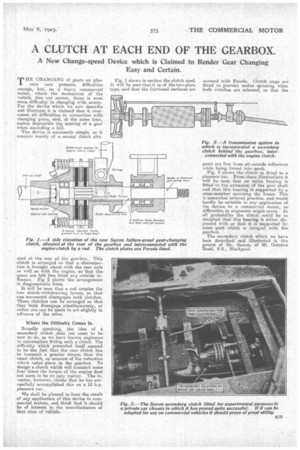A CLUTCH AT EACH END OF THE GEARBOX.
Page 21

If you've noticed an error in this article please click here to report it so we can fix it.
THE CHANGING of gears on pleasure cars presents difficulties enciiigh, but, on a heavy commercial motor, where the momentum of the vehicle dies out sooner, there is even more difficulty in changing with nicety. For the device which we now describe and illustrate it is claimed that it overcomes all difficulties in connection with changing gears, and, at the same time, makes impossible the missing of a gear -when ascending a hill.
The device is extremely simple, as it consists merely of a second clutch situ ated at the rear of the gearbox. This clutch is arranged so that a diseonnection is brought about with the rear axle as well as with the engine, so that the gears are left free from any outside influence. Fig 2 shows the arrangement in diagrammatic form.
It will be seen that a .rod couples the Iwo clutch-withdrawing levers, so that one movement disengages both clutches. These clutches can be arranged so that they both disengage simultaneously, or either One can be made to act slightly in advance of the other.
Where the Difficulty Comes In.
Broadly. speaking, ,the idea, of a secondary clutch does not seem to be new to us, as we have known engineers to contemplate fitting such a clutch. The difficulty Which presented itself seemed to be the fact that the rear clutch has to transmit a greater torque than the usual clutch, on account of the reduction which takes place in the gearbox. To design a clutch which will transmit some four times the torque of the engine does not seemto be an easy matter. The in-. venter, however, claims that he has successfulli accomplished this on a 12 h.p. pleasure car.
We shall be pleased to hear the result of any application of this device to commercial motors, and think that it should be of interest to the manufacturers of that class of vehicle.
covered with Ferodo. Clutch stops are fitted to prevent undue spinning when both clutches are released, So that the Fig. 2.—A transmission system in which is incorporated a secondary clutch behind the gearbox, interconnected with the engine clutch.
gears are free from all outside influences while being fdrced into mesh.
Fig. 3 shows the clutch as fitted to a pleasure car. From these illustrations it will be seen that an extra bearing is fitted to the extension of the gear shaft and that this bearing is supported by a cross-member spanning the frame. This is somewhat unusual practice, and would hardly be suitable in any application of the device to a commercial motor, difficulties in alignment might occur. In all probability the clutch could be so designed that this bearing is either dispensed with or that it is supported by some Tart which is integral with the gearbox.
The secondary clutch which we have here described and illustrated is the patent • of Mr. Saxon, of 90, Osborne; Road, S.S., Blackpool.


































